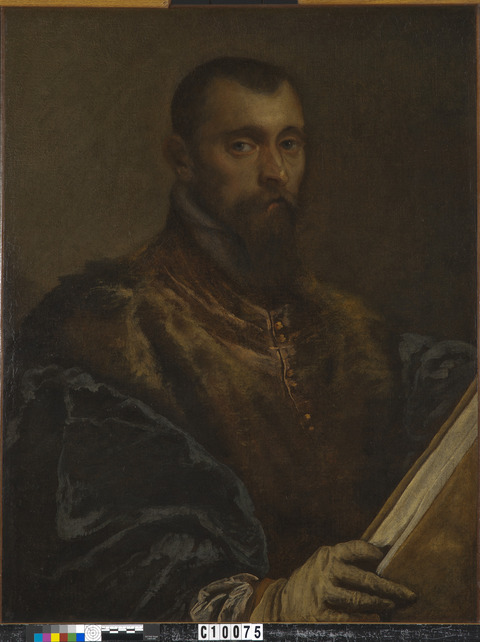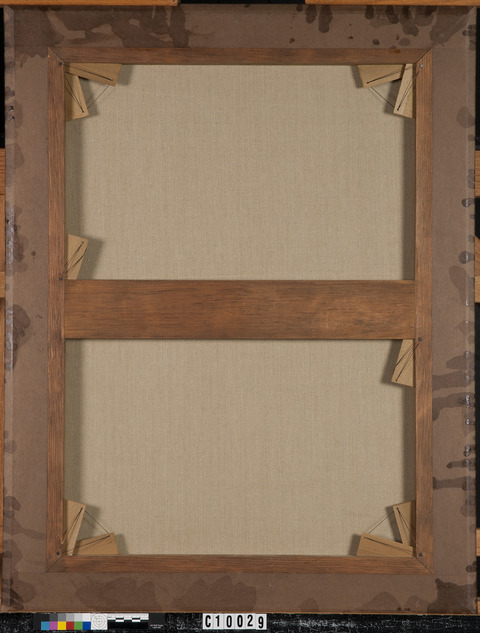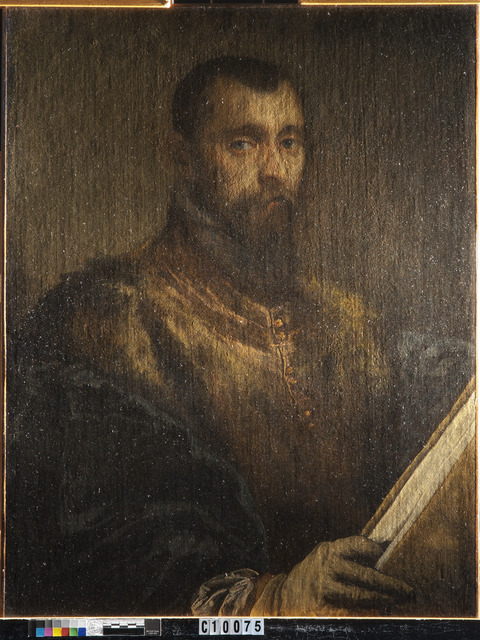Overview
Accession number: 2016.163
Artist: Attributed to Leandro Bassano
Title: Portrait of a Man
Materials: Oil (untested) on canvas
Date of creation: About 1590–1600
Previous number/accession number: C10075
Dimensions: 75.5 x 58.2 cm
Conservator/examiner: Fiona Beckett
Examination completed: 2014, revised 2020
Distinguishing Marks
Front:
None
Back:
None
Summary of Treatment History
The painting was treated shortly after entering the possession of Dr. Clowes. Two early treatments took place in 1941 by Anthony Ripportella,1 and letters between Dr. Clowes and William Suhr suggest that Suhr treated the painting in 1955–56.2 The canvas has what appears to be a twentieth-century glue lining, perhaps performed during one of these treatments, and evidence of retouching is visible in ultraviolet-induced visible fluorescence.
Documentation suggests a series of condition assessments and treatments were carried out on the collection around the time the works were moved from the Clowes residence to the IMA in 1971. A condition report by Paul Spheeris in October of that year, likely carried out before the paintings were relocated, described the frame as in poor condition but the painting as “O.K.” He recommended cleaning for the sake of the work’s appearance but not for its safety.3 A second condition assessment was carried out upon arrival of the paintings at the IMA. This assessment describes the work as being in good condition, and minor treatment to the frame was carried out.4
In 1996, a memorandum summarizing treatment and examination of the Clowes Collection from the time it entered the Museum notes that the painting underwent a full treatment in 1989.5 The treatment involved surface cleaning, thinning of the varnish with a solvent mixture (5% diacetone alcohol, 10% acetone, 85% petroleum benzene), applying a brushed varnish coating of Paraloid B-72 (10%), inpainting with dry pigments and Paraloid B-72, and varnishing with Paraloid B-72 (5%).6
The painting was examined and documented in the Clowes Collection annual survey of 2011 to 2020.
Current Condition Summary
Aesthetically, the painting is in relatively good condition. A discolored varnish obscures some of the original vibrancy of the colors, and while there are significant areas of retouching, most of this is in the background and does not cover the portrait itself. The painting is structurally sound with previous treatments intact.
Methods of Examination, Imaging, and Analysis
| Examination/Imaging | Analysis (no sample required) | Analysis (sample required) |
|---|---|---|
| Unaided eye | Dendrochronology | Microchemical analysis |
| Optical microscopy | Wood identification | Fiber ID |
| Incident light | Microchemical analysis | Cross-section sampling |
| Raking light | Thread count analysis | Dispersed pigment sample |
| Reflected/specular light | X-ray fluorescence spectroscopy (XRF) | Fourier-transform infrared spectroscopy (FTIR) |
| Transmitted light | Macro X-ray fluorescence scanning (MA-XRF) | Raman microspectroscopy |
| Ultraviolet-induced visible fluorescence (UV) | ||
| Infrared reflectography (IRR) | Gas chromatography–mass spectrometry (GC-MS) | |
| Infrared transmittography (IRT) | Scanning electron microscope -energy dispersive X-ray spectroscopy (SEM-EDS) | |
| Infrared luminescence | Other: | |
| X-radiography |
Technical Examination
Description of Support
Analyzed Observed
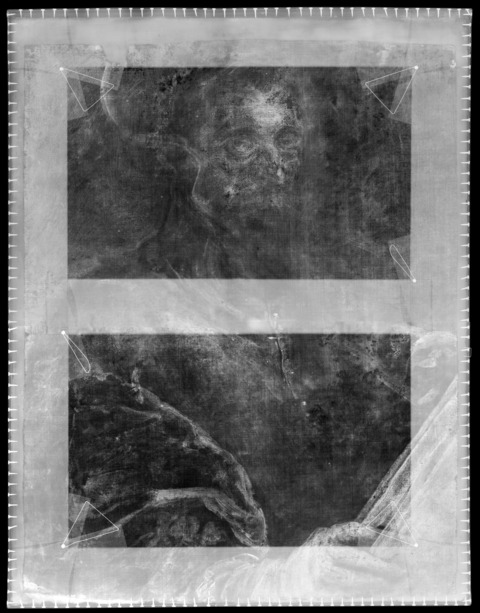
Material (fabric, wood, metal, dendrochronology results, fiber ID information, etc.):
The original canvas exhibits a plain weave with a thread count of 15 × 14 threads/cm (tech. fig. 2). The canvas has relatively coarse weave with evenly spaced thread and a few slubs appearing occasionally.
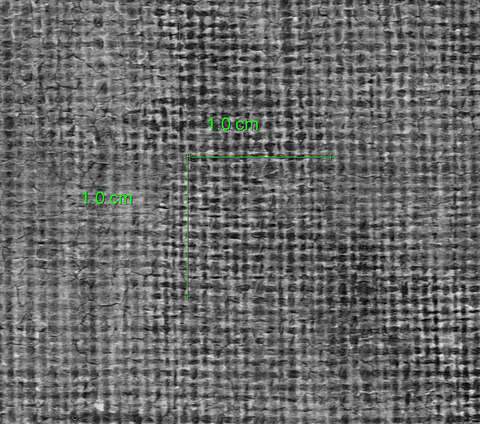
Characteristics of Construction / Fabrication (cusping, beveled edges of panels, seams, joins, battens):
The original canvas was trimmed and no longer exhibits any tacking margins. There is no sign of cusping (tech. fig. 1), suggesting that the painting was significantly cut along all edges. It was likely cut by hand at the time the lining was applied.
The painting has been lined with a glue adhesive to a medium-weight, plain-weave canvas. This was likely carried out in the twentieth century. The lining technique includes the addition of numerous tacks along the edges, a new stretcher and keys, and brown paper tape on all four sides that obscures the lining canvas.
Thickness (for panels or boards):
N/A
Production/Dealer’s marks:
None
Auxiliary Support:
Original Not original Not able to discern None
Attachment to Auxiliary Support:
The auxiliary support is a five-member stretcher with one crossbar and ten of ten keys present. The stretcher is not original to the painting. The original canvas support does not extend to the painting’s edges.
Condition of Support
The support is in stable condition, with good adhesion between the original canvas and the lining canvas. The canvas is taut and in plane.
Description of Ground
Analyzed Observed
Materials/Binding Medium:
Likely an oil-based ground, although further testing would be necessary to confirm this.
Color:
The ground layer is an off-white color that appears to have yellowed slightly over time. A reddish imprimatura layer is also present over most of the white ground.
Application:
Unknown, possibly scraped over the surface with a hard-edged tool
Thickness:
Appears to be a very thin layer of white ground layer followed by a red imprimatura layer, which can be seen in the cracks when viewed under the microscope. The white ground was scraped across the canvas sparingly, likely just enough to cover the canvas. In some areas, nubs of the bare canvas are visible, particularly when analyzing the painting under the microscope.
Sizing:
A size layer would have been applied to the original canvas prior to the application of a ground layer.
Character and Appearance (Does texture of support remain detectable / prominent?):
The canvas texture remains visible through the paint and ground layers.
Condition of Ground
The ground appears to be in stable condition, and the adhesion between the ground layer and the canvas remains intact. A natural aging cracking network beginning in the ground layer is visible through to the upper paint layers, but the paint remains stable.
Description of Composition Planning
Methods of Analysis:
Surface observation (unaided or with magnification)
Infrared reflectography (IRR)
X-radiography
Analysis Parameters:
| X-radiography equipment | GE Inspection Technologies Type: ERESCO 200MFR 3.1, Tube S/N: MIR 201E 58-2812, EN 12543: 1.0mm, Filter: 0.8mm Be + 2mm Al |
|---|---|
| KV: | 20 |
| mA: | 3 |
| Exposure time (s) | 90 |
| Distance from X-ray tube: | 36″ |
| IRR equipment and wavelength | Opus Instruments Osiris A1 infrared camera with InGaAs array detector operating at a wavelength of 0.9-1.7µm. |
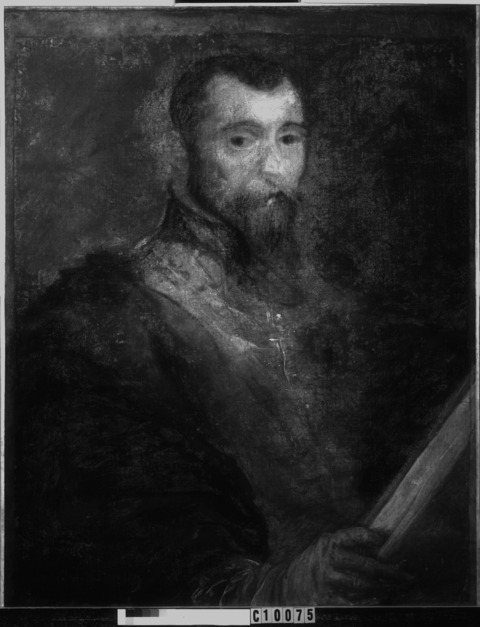
Medium/Technique:
Unknown
Pentimenti:
No pentimenti are discernible (tech. fig. 3). Some slight adjustments and reinforcements of the figure using paint are present, for example in the folds of the coat around the neck and in the facial hair. Numerous damages are also visible in the infrared reflectogram, particularly in the background and around the head of the figure. Additionally, there are some wavy lines visible in the X-radiograph that appear to be painted with lead white on the proper right near the figure’s head. These do not correspond to the composition, and the reason for their presence is unclear. The original edge of the canvas is visible in the reflected infrared image, and it is apparent that the canvas was quite damaged, especially at the top edge where holes and tears are present.
Description of Paint
Analyzed Observed
Application and Technique:
The paint layer has been delicately applied in the face of the figure, and subtle tonal changes appear in the garments. There are a few areas of slight impasto in the sitter’s garments, but most of these areas have been somewhat flattened, likely during the lining process.
Painting Tools:
Brushes of varying sizes, no evidence of palette knife or other hard-edged tools
Binding Media:
Oil (untested)
Color Palette:
The color palette consists of earth tones, pinks, yellows, some white and lighter colored highlights in the details, and dark blue for the sleeves. It is difficult to discern through the heavy varnish and previous abrasion, but transparent glazes may have been used in several areas of the composition as well.
XRF analysis (tech. fig. 4, table 1) indicates that lead white and iron oxide (earth pigments) were used throughout the painting. Lead white, iron oxide, vermilion, and umber were used for the skin tones. Azurite was used in the blues of the shirt. Significant amounts of old retouching are also present, which accounts for the detection of titanium, zinc, and chromium that suggest the use of titanium white, zinc white, and possibly chrome yellow. The background, in particular, has significant amounts of retouching covering previous damages.
XRF Analysis:
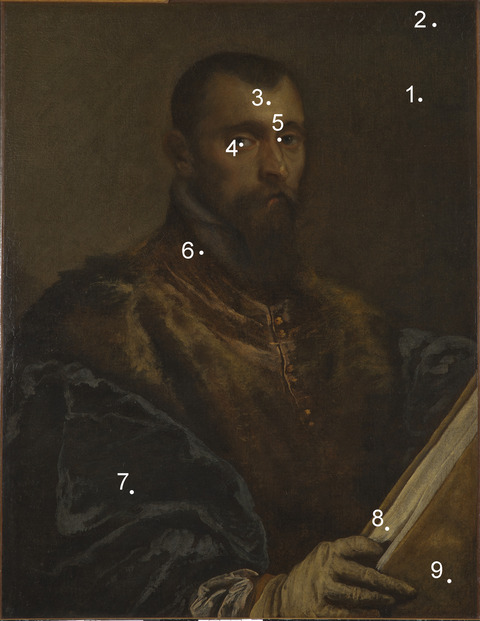
| Sample | Location | Elements | Possible Pigments |
|---|---|---|---|
| 1 | Greenish background | Major: Fe, Pb, Ca Minor: Trace: Cu, Zn, K, Ti, Mn, Sr | Iron oxide (earth pigments including umber), lead white, calcium (from ground layer), trace of copper-containing blue and/or green pigment, trace of zinc white (from retouching). |
| 2 | Green background (retouching) | Major: Fe, Ca, Pb Minor: Zn, Ti Trace: Cr, Ni | Iron oxide (earth pigments including umber), calcium from ground, lead white, zinc white, titanium white, trace of chrome-containing pigment. |
| 3 | Skin tone, forehead | Major: Pb, Fe Minor: Trace: Mn, Hg, Ca, Ti, Cu, K | Iron oxide (earth pigments including umber), lead white, trace of vermilion, trace of calcium (from ground layer), trace of copper-containing blue and/or green pigment. |
| 4 | Blue in eye | Major: Pb, Fe Minor: Trace: Mn, Hg, Ca, Ti, Cu, K | Iron oxide (earth pigments including umber), lead white, trace of vermilion, trace of calcium (from ground layer), trace of copper-containing blue and/or green pigment. |
| 5 | Pink in eyelid | Major: Pb, Fe Minor: Hg Trace: Mn, Ca, Ti, Cu, K | Iron oxide (earth pigments including umber), lead white, vermilion, trace of calcium (from ground layer), trace of copper-containing blue and/or green pigment. |
| 6 | Pink-red in vest | Major: Pb, Fe Minor: Trace: Hg, Mn, Ca, Ti, Cu, K | Iron oxide (earth pigments including umber), lead white, trace of vermilion, trace of calcium (from ground layer), trace of copper-containing blue and/or green pigment. |
| 7 | Dark blue in shirt | Major: Pb, Fe Minor: Cu, Ca, Mn Trace: K, Ti | Iron oxide (earth pigments including umber), lead white, copper-containing blue and/or green pigment, calcium (from ground layer). |
| 8 | White in book | Major: Pb Minor: Fe Trace: Ca, Ti | Lead white, iron oxide (earth pigments), trace of calcium from ground layer. |
| 9 | Yellow in book | Major: Pb, Fe Minor: Trace: Ca, Mn | Iron oxide (earth pigments including umber), lead white, trace of calcium (from ground layer). |
Table 1: Results of X-ray fluorescence analysis conducted with a Bruker Artax microfocus XRF with rhodium tube, silicon-drift detector, and polycapillary focusing lens (~100μm spot).
*Major, minor, trace quantities are based on XRF signal strength not quantitative analysis
Surface Appearance:
The paint appears to be applied relatively thinly throughout most of the painting, with a few areas of impasto (much of which has been flattened due to the lining process).
Condition of Paint
A micro-cracking pattern from natural aging extends over the entire painting. Large passages of loss due to previous damages and abrasion are present throughout much of the painting, but primarily in the background and the area on the proper left of the sitter. These are covered with retouching and a natural resin varnish. Some wear is visible around the perimeter of the painting where the paint is in contact with the frame.
Description of Varnish/Surface Coating
Analyzed Observed Documented
| Type of Varnish | Application |
|---|---|
| Natural resin | Spray applied |
| Synthetic resin/other | Brush applied |
| Multiple Layers observed | Undetermined |
| No coating detected |
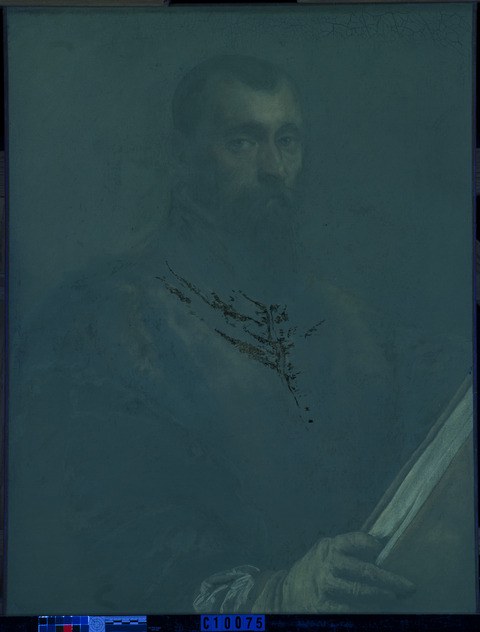
Ultraviolet-induced visible fluorescence reveals that there is a coating of natural resin varnish present over the entire surface of the painting (tech. fig. 5). The varnish appears to be slightly yellowed. There are several campaigns of retouching from an older restoration and inpainting from a more recent campaign. The older campaigns are obscured by the natural resin varnish, and the more recent campaign can be seen in ultraviolet-induced visible fluorescence. A spritzing technique (tech. fig. 6) was used for some of the retouching around the edges and extends into the composition. Paraloid B-72 was applied in 1989 to saturate the colors, even out the previous coating, correct some blooming, and provide protection to the painting. According to the report on file at the IMA, the natural resin varnish is slightly soluble in isopropanol, and readily soluble in acetone.
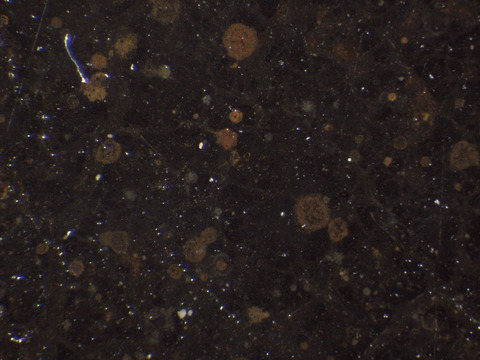
Condition of Varnish/Surface Coating
The natural resin varnish is discolored, imparting a yellowed look to the painting. The varnish no longer saturates the painting adequately.
There are significant areas of retouching and inpainting visible. The paint appears slightly yellow due to discolored varnish over the surface.
Description of Frame
Original/first frame
Period frame
Authenticity cannot be determined at this time/ further art historical research necessary
Reproduction frame (fabricated in the style of)
Replica frame (copy of an existing period frame)
Modern frame
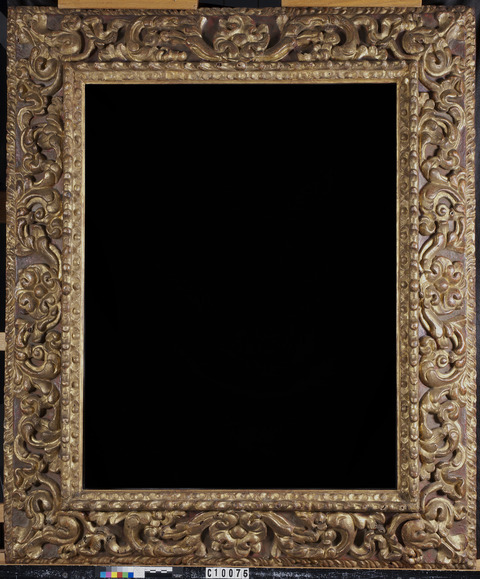

Frame Dimensions:
Outside frame dimensions: 104 × 87.5 cm
Sight size: 74.5 × 57 cm
Rebate dimensions: 77 × 59.5 cm
Distinguishing Marks:
Item 1. White rectangular label with red trim, back, top right corner: “2429/1” (tech. fig. 8).
Item 2. Black marker, back, top right: “839#1”(tech. fig. 8).
Item 3. White rectangular label, back, top left corner: “TR#10075”(tech. fig. 8).
Item 4. Writing in pencil, back, left member, illegible (tech. fig. 8).
Description of Molding/Profile:
According to frame specialist Timothy Newbery, the frame is from the eighteenth century and originates in northern Spain. The frame is miter-lapped, carved, and gilt. The sight edge is decorated with egg-and-dart trim, while the outside edge portrays fluted leaves from the center (tech. fig. 9). The frieze is sloped. At the center of each member are patera, which are surrounded by cauliculi extending to the corners (tech. fig. 7). The ornamentation has raking leaves with rocaille-style decorations.7 The original gilding, the rocaille, and the manner of frieze carving indicate the frame is of the Rococo period.
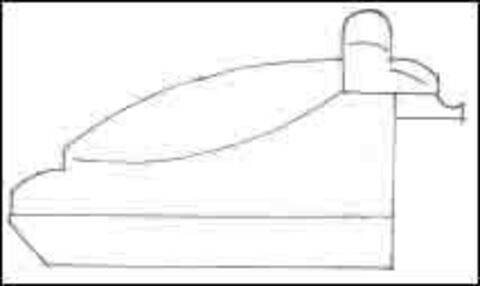
Some adjustments were made to the frame, including the trimming of the sight edge and the addition of a small, hollow molding. The red background of the frieze was painted over with a gray-brown paint. An oak backing with butt joined planks was applied to reinforce the structure of the frame (tech. fig. 8).
Condition of Frame
The frame is in stable condition; however, it has suffered from woodworm damage in the past, and many areas of the frame show woodworm holes. The top edge detached in the past, and the entire frame was built up with wood to strengthen it.
Newbery recommended repairing the break under the top edge molding and the integration of additional sight molding.
Notes
-
Jacob M. Heinmann and G.H.A. Clowes, 24 August 1941, 27 August 1941, and 2 September 1941; and telegram (via Eli Lilly & Co.) from G.H.A. Clowes to Leo Kipnis (Heinmann’s newphew), 29 November 1941, Correspondence Files, Clowes Registration Archive, Indianapolis Museum of Art at Newfields. ↩︎
-
Letter from G.H.A Clowes to William Suhr, 7 July 1955, Correspondence Files, Clowes Registration Archive, Indianapolis Museum of Art at Newfields. ↩︎
-
Paul A.J. Spheeris, “Conservation Report on the Condition of the Clowes Collection,” 25 October 1971, Conservation Department Files, Indianapolis Museum of Art at Newfields. ↩︎
-
Martin Radecki, Clowes Collection condition assessment, undated (after October 1971), Conservation Department Files, Indianapolis Museum of Art at Newfields. ↩︎
-
Memorandum from Martin Radecki to Bret Waller, “Conservation Work on Clowes Fund Collection,” 16 February 1996, Conservation Department Files, Indianapolis Museum of Art at Newfields. ↩︎
-
Linda Witkowski, treatment report, C10075 (2016.163), November 1989, Conservation Department Files, Indianapolis Museum of Art at Newfields. ↩︎
-
Timothy Newbery, frame specialist. Examination completed at the Indianapolis Museum of Art on 16 January 2012. ↩︎
Additional Images
